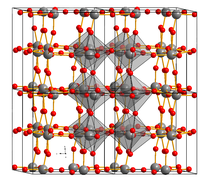
Photo from wikipedia
Abstract A series of K-ZrO2/Cu/Al2O3 catalysts (KZCTA (T = 600–900 °C)) were prepared by a sequential impregnation method and investigated for the direct synthesis of ethanol and isobutanol from syngas. The calcination temperature… Click to show full abstract
Abstract A series of K-ZrO2/Cu/Al2O3 catalysts (KZCTA (T = 600–900 °C)) were prepared by a sequential impregnation method and investigated for the direct synthesis of ethanol and isobutanol from syngas. The calcination temperature for CTA (T = 600–900 °C) preparation had considerable effect on the structure and catalytic performance of KZCTA catalysts. By increasing the calcination temperature from 600 to 900 °C, the CO conversion was promoted obviously from 20.3 to 53.0%. When the calcination temperature was lower, KZC700A catalyst showed high isobutanol selectivity of 17.7 wt%, while only a small amount of isobutanol was obtained in the reference catalysts of KZA and KC700A without Cu or Zr as promoters. The coexistence of Cu and Zr in the catalyst was required for isobutanol formation. Furthermore, the Cu-ZrO2 interface amounts increased firstly with the increase of calcination temperature and then decreased at over-higher calcination temperature because of the aggregation of ZrO2. The isobutanol selectivity changed with the Cu-ZrO2 interface amounts in catalyst, suggesting that the Cu-ZrO2 interfaces were responsible for isobutanol preferable synthesis directly from syngas. In addition, ethanol selectivity increased clearly up to 36.3 wt% when the higher calcination temperature 900 °C was employed for catalyst preparation. In comparison with the KZC900A catalyst, the catalyst of KC900A prepared without Zr as promoter exhibited excellent catalytic performance for the ethanol synthesis (33.5 wt%). It revealed that Zr cannot contribute to ethanol formation, and the newly formed CuAlO2 phase under higher calcination temperature in the catalysts possibly favored ethanol formation. As confirmed by XRD, Raman spectroscopy and H2-TPR, the CuAlO2 phase emerged and its amount increased with the increase of calcination temperature for catalyst preparation. A good linear relationship was found between ethanol selectivity and the amount of CuAlO2, proving that the CuAlO2 phase acted as efficient active sites for ethanol preferable synthesis directly from syngas.
Journal Title: Fuel
Year Published: 2018
Link to full text (if available)
Share on Social Media: Sign Up to like & get
recommendations!